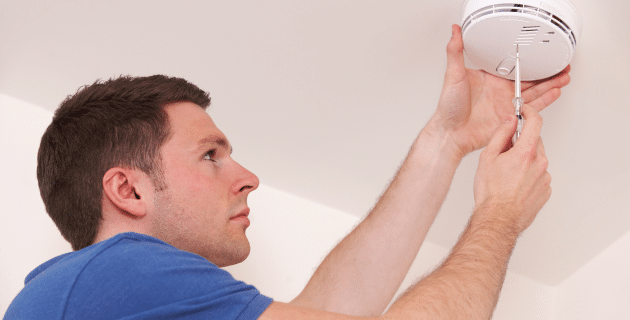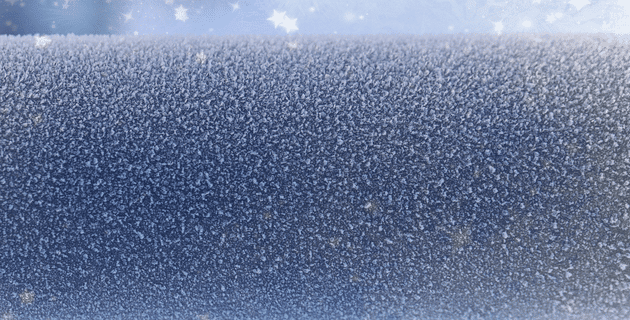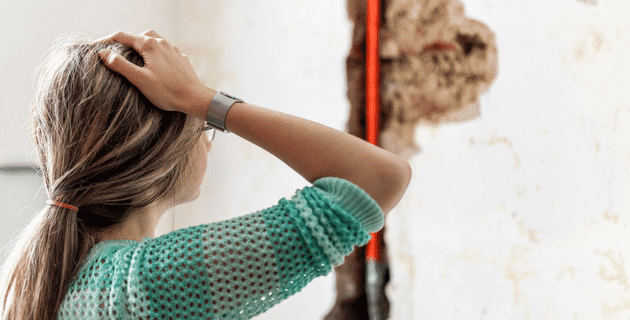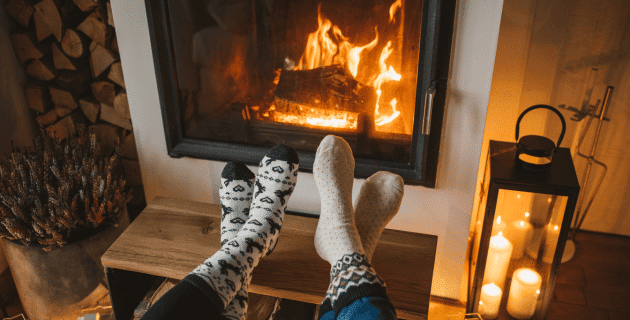
by California Casualty | Helpful Tips, Homeowners Insurance Info, Safety |
If you’ve ever accidentally set off the smoke alarm, you know how loud it can be. But that loud beeping is actually a good thing. Smoke detectors give us that important warning to get safely away in case of a fire. Some detectors do double duty and also alert to carbon monoxide.
However, don’t assume your smoke detectors are working if you’ve installed them once and then never touched them again. Batteries wear out, and detectors have a lifespan of only about 10 years. That’s why it’s important to test yours regularly and there is no better time than when you are spring cleaning.
Two types of detectors
You may have a battery-powered smoke detector or yours may be hard-wired. They look the same from the outside but they’re a little different.
-
- A hard-wired detector is connected to your home’s electrical power with a cable that runs behind your wall or ceiling. They usually have a battery backup in case the power goes out. It is recommended that these detectors are installed by a professional electrician.
-
- The battery-powered detector snaps into a plastic base that is screwed onto the ceiling or wall. In many newer models, batteries are non-removable and come with a 10-year warranty.
Follow these steps
Both types of smoke detectors have a test button that allows you to check if they are working. Test your smoke detectors at least twice a year, once in the spring and once in the fall, and replace them as needed.
Step 1: Let family members know you’ll be testing.
A smoke alarm could cause family members to think there is a real emergency, so let them know that you are going to run a test. Since the sound could frighten small children and pets, you may want to test while they are not around. In addition, if your smoke detector is connected to an alarm company, notify them or you could have the fire department show up at your door.
Step 2: Position someone away from the detector.
Ask a family member or friend to stand on another level of the house, to make sure the alarm is heard. You want to make sure that the warning is heard downstairs in the basement and upstairs, in case someone might be there when it sounds.
Step 3: Press and hold the test button.
You may need to stand on a chair or a ladder to reach the button on your detector. You can use a broom handle if you are able to reach it that way. Note that it may take a few seconds to start. You will hear a loud siren. If there is no sound or a weak one, the batteries and/or the detector need replacement. Make sure to repeat this test with every smoke detector in the house or apartment.
Pro Tip: Some smoke detectors can go into programming mode if you hold the button too long. Wait for the detector to return to normal before testing it.
Step 4: Try this way to check your detector’s sensor.
The test button checks that your detector is powered. However, it doesn’t check the smoke sensor. You can do so with an aerosol spray that you can purchase for a few dollars at a hardware store. Follow the directions on the can to spray the “smoke.” This is a safer way to check the sensor than lighting matches. After the test, you can use a handheld vacuum to remove the material from the detector.
Pro Tip: Some detectors have a button to push to stop the alarm. Find out if yours has one before you run this test.
Other important tips
-
- If you have a detector where you have to change the batteries, you should replace them twice a year. (When we change the clocks is a great time to do that.) If your smoke detector is older than 10 years, you should replace it even if it is working.
-
- Dust and dirt build-up can affect your detector. Keep your detectors clean.
-
- Don’t paint your detector to match your décor. That can interfere with their ability to detect smoke.
-
- Make sure you have enough detectors in your home or apartment. You should have one in your kitchen, but 10 feet away from cooking to avoid false alarms. You also will want to place them inside every bedroom and outside each sleeping area, on every level of your home, and in places where you keep flammable substances like the garage.
You want to be fully prepared in case of a fire, and not just with smoke detectors. Talk with your insurer about your home and property to ensure that you are fully covered.
This article is furnished by California Casualty, providing auto and home insurance to educators, law enforcement officers, firefighters, and nurses. Get a quote at 1.866.704.8614 or www.calcas.com.

by California Casualty | Homeowners Insurance Info |
Your house may be warm and cozy, but chances are your water pipes aren’t. When temperatures dip too low, those pipes are in danger of freezing and bursting. If that happens, you’re in for a hefty bill…
Causes of burst pipes
Winter is a common season for frozen pipe bursts. That’s because water expands when it freezes. So, when the water in your pipes becomes ice, it takes up more space and pushes against the sides of your metal or plastic pipes. That pressure continues to build up. When it reaches the breaking point, a pipe can burst and send water flowing.
Pipes can also burst for other reasons. This includes corrosion, as pipes rust and weaken over time. Tree roots can interfere with outside pipes. Shifting soil from construction around your home has a similar effect. Finally, clogs from toilet paper and hair can be large enough to cause pipes to burst.
What to do if your pipes burst
You want to take quick action if a pipe has burst in your house. Here’s what to do.
1. Turn off the main water supply. This will keep the water from flowing uncontrollably. If you live in an apartment building, you won’t have access to the main shutoff valve. Contact your landlord right away so he or she can take action. (Pro Tip: Most main water shutoff valves are located close to your water heater or furnace.)
2. Shut off the power. This will help ensure that you don’t get electrocuted through highly charged water that has come in contact with your electrical system.
3. Call a plumber. When pipes burst, it’s best to let a professional handle the problem. If you know that water has affected your electrical system, call an electrician as well.
4. Drain the pipes. You want to get the water out of your pipes to avoid more freezing, bursting, and leaking. With the water main still off, turn on all the cold taps and let the water run. Then turn off your hot water heater and turn on the hot taps. Let the water run. Finally, flush all the toilets.
5. If you turn on the water and only a trickle comes out, you may still have a frozen pipe. Keep the faucet on. As you defrost the ice ball, you want water to be able to flow freely. Use a hair dryer to safely thaw the pipes. Move it around to reach as many places as possible. Alternatively, wet some towels in hot water and place them across the pipes. Replace them as they cool. Do not use an open flame to warm your pipes. That could cause a fire or damage the pipes.
6. Assess the damage. Figure out where the broken pipe is. A plumber can help you to do this.
7. Contact your insurance agent. They will advise you on how to file a claim, and also what the policy may cover. They will send a representative out to inspect the damage.
8. Clean up any standing water. A wet/dry vacuum will pull water from carpets. Dehumidifiers also can help. You will need to clean the area thoroughly. Consider a professional repair that can help prevent future costly problems like mold.
How to prevent frozen pipes
You can take steps to prevent your pipes from freezing and bursting. Follow this checklist.
1. Pipes most likely to freeze are outside or in unheated areas of your home like basements, attics, crawl spaces, garages, and cupboards. These include outdoor hose bibs, swimming pool supply lines, water sprinkler lines, and pipes close to the outside of the house.
2. Add insulation to these places, such as your attic, basement or crawlspace. You can cover your pipes with insulation, too. You can find it at your local hardware store. Measure the length of the pipe and cut the insulation foam to size. Wrap the pipe with insulation. Seal the seam with tape.
3. Consider heat tape which is not tape at all but a type of wiring. It looks like an extension cord that plugs into a wall and then wraps around the pipe. If you use heat tape, make sure it is designated for water pipes and properly installed. Check the tape monthly while in use. Remove it if there are cracks, bite marks, or signs of deterioration.
4. Caulk the cracks in your walls and foundation to keep cold air out. Ask a professional contractor to make sure that your basement is appropriately sealed.
5. Remember to turn off outdoor water faucets in winter. Disconnect your garden hoses. Drain water from sprinkler and swimming pool lines. Do not put antifreeze in these lines, as it is environmentally harmful and dangerous to people, pets, and wildlife.
6. When temperatures are very cold outside, turn a faucet on cold and let it drip to a trickle. This keeps water flowing and helps prevent freezing. (Pro Tip: Put a bucket underneath to collect that water and use it to water your plants.)
7. Open kitchen and bathroom cabinet doors to allow heat to circulate. Just make sure to relocate or safeguard any chemicals that could be hazardous to children or pets.
8. Set up fans to blow heat into colder rooms. Or use space heaters. You can add a space heater to a room where pipes are exposed; however, use caution. Make sure it’s plugged into an outlet with a ground fault circuit interrupter to prevent electric shock. Do not use an extension cord and only use the space heater when you are home.
9. Keep your thermostat set to the same warm setting day and night. If you plan to be away from home for any length of time, make sure that the thermostat is set to at least 55 degrees Fahrenheit to help protect against frozen pipes.
10. Consider relocating your pipes if you continually have issues with freezing.
Your home is one of your greatest investments. Protect it with the right insurance.
This article is furnished by California Casualty, providing auto and home insurance to educators, law enforcement officers, firefighters, and nurses. Get a quote at 1.866.704.8614 or www.calcas.com.

by California Casualty | Auto Insurance Info, Finances, Homeowners Insurance Info |
From groceries to gas, it seems like we’re paying more for everything these days. Now insurance rates are increasing as well. Why is this happening, and more importantly, what can we do about it? Here’s what you need to know.
What we’re seeing…
Car insurance rates rose 9% over the course of 2022, a trend that is expected to continue with another 7% rate growth in 2023 according to Insurify. Home insurance rates increased by an average of 12.1% in 2021, and another 3% in 2022 said Bankrate.com. Experts predict rate increases each year for the next few years due to the perfect storm of inflation, supply chain issues, weather changes, and other factors.
We’re experiencing historic inflation.
Inflation is at its highest level in decades. Inflation has had a significant impact on the cost of auto parts and labor, as well as medical expenses for bodily injuries.
From March 2021 to March 2022, here’s how prices have increased:
-
-
- Medical services – increased 2.9%
- Auto repair costs – increased 4.9%
- Car rental costs – increased 13.8%
- Used vehicles – increased 35.3%
Similarly, the costs associated with a home claim also have been affected by inflation. This includes additional temporary living expenses, replacement of personal property and home furnishings, cost of construction labor, and costs of construction supplies.
From March 2021 to March 2022, here’s how prices have increased:
-
-
- Rent – increased 5.1%
- Home furnishings – increased 10.1%
- Construction labor and trade services – increased 21.3%
- Construction materials and goods – increased 22.2%
Supply Chain Issues
There are supply chain issues created by the pandemic and by a labor shortage. When we can’t get parts or supplies to repair a vehicle or a home, the process becomes lengthier and results in repairs simply costing more.
Other Factors
The severity and frequency of vehicle accidents are on the rise. Traffic fatalities reached a 16-year high in 2021 according to the National Highway Traffic Safety Administration, due to an increased trend in post-pandemic risky driving behaviors – speeding, driving distracted, not wearing seatbelts, and driving under the influence. This rise in accidents directly affects claims, which contributes to rising auto insurance costs.
Similar conditions come into play for home insurance costs. The number of extreme climate events and weather disasters is also increasing. In 2022, there were 18 disasters with losses of more than $1 billion each, according to the National Centers for Environmental Information.
An inside look at how this affects your insurance rate
As material and labor costs rise, the cost to repair and replace damaged homes and vehicles increases. Factor in the ongoing supply chain issues and costs increase even more. The amount you pay for insurance is likely to go up when the cost to settle claims rises.
“But I’ve never been in an accident, so why would my rate go up?”
Even if you have a spotless driving record or never filed a claim, it’s likely that your insurance costs could be impacted due to economic factors that are out of your control – regardless of the company that provides your coverage. Insurers across the country have been raising rates, some multiple times in the past 12 months. However, it’s not all doom and gloom. There are ways you may be able to reduce your costs.
What You Can Do to Lower Your Premiums
Your insurance provider can recommend adjustments that still give you the quality coverage you need but with a lower premium. Start with a thorough policy review and make sure to look at these areas.
• Review deductible options. Generally, the higher your deductible, the lower the cost of your insurance premium. Since the deductible is the amount your insurance provider will subtract from an insurance payout, you’ll have to select a deductible that you’re comfortable paying out-of-pocket after a loss. Note that there can be diminishing returns if you set your deductible much higher than average, so as a consumer, you need to balance the premium savings against the amount you’d be required to pay after a loss.
• Take advantage of discounts. You may qualify for insurance discounts for being part of a professional association, such as groups for teachers, nurses, or first responders. There are also discounts for being retired, good student discounts, setting up automated payments, and for paying in full upfront. You may also receive a discount for quoting online.
• Buy home and auto insurance from the same company. When you bundle your home and auto insurance, you can often qualify for reduced rates, saving hundreds of dollars.
• Remove Gap coverage if no longer needed. When you buy or lease a new vehicle, it starts depreciating once you drive it off the lot. Gap insurance ensures that you will get the full replacement value of your car if it is totaled or stolen. As a car begins to age, this gap goes down and the need for coverage is less.
• Make your home disaster resistant. Talk to your insurance agent about how you can disaster-proof your home. You may be able to save on your premiums by adding storm shutters, reinforcing your roof or buying stronger roof materials, or even clearing brush from around your home. Older homes can be retrofitted to make them better able to withstand earthquakes or other natural disasters. In addition, consider modernizing your heating, plumbing, and electrical systems to reduce the risk of fire and water damage.
• Choose electronic documents rather than mail. This is an easy change that often comes with a discount and can add up in the long run.
• Skip a payment. Some insurance companies allow you to skip payments around the holidays. At California Casualty, you have the option to skip payments during the summer or holiday months when budgets tend to be extra tight. Ask your agent for details.
California Casualty has been slower with rate increases than the bigger carriers. We will always strive to keep our prices as affordable as possible for our members. When we do make rate changes, it is to be able to maintain the financial fortitude to keep our promises to every policyholder during their time of need.
This article is furnished by California Casualty, providing auto and home insurance to educators, law enforcement officers, firefighters, and nurses.

by California Casualty | Homeowners Insurance Info |
We all know the dreaded drip, drip, drip of a water leak. It’s the sound of a potentially expensive repair or at minimum, an annoying cleanup. Either way, you want to be prepared when it happens. Knowing what your homeowner’s insurance covers in terms of plumbing and pipe leaks is the first step.
In general, sudden plumbing issues are typically covered by insurance but plumbing problems that occur over time due to lack of maintenance may not be. The policy may cover damage resulting from plumbing breakdowns, but it won’t cover the cost to repair the plumbing itself. Insurance is intended to help in emergencies, not a substitute for regular maintenance.
What Insurance (Probably) Does Not Cover
Most policies do not cover old plumbing and pipe leaks. If you’ve got a slow leak and you ignore it until it gets worse, that’s likely not covered by your homeowner’s policy. When you file a claim, your insurance company will send an adjuster. They will determine the cause of damage, and decide whether it qualifies for coverage. Here are general guidelines on what insurance probably does not cover.
-
- Normal wear-and-tear and lack of maintenance are not covered. If you neglect your plumbing and pipes, you essentially have voided your policy.
-
- Leaks that started small and have gotten progressively worse over a period of years are not covered. The time to address them was when they started.
-
- Pipes that freeze because you turned off the heat would be categorized under neglect. So, if you went away on a winter vacation, and failed to take the necessary steps to protect your pipes, the damage that results may not be covered under your policy.
-
- Mold may be excluded from your standard policy. However, you could purchase additional coverage.
-
- Water damage from any flooding is not covered unless you have a flood policy.
What Insurance (Probably) Covers
From certain plumbing issues to broken, burst, or frozen pipes, your homeowner’s policy probably covers the ensuing damage if you have taken reasonable care and performed continued maintenance. For example, coverage for freezing of a plumbing system only applies if you “maintain heat in the building; or shut off the water supply and drain all systems and appliances of water.”
Insurance pays to repair the pipes or plumbing in these cases. It also compensates you for covered items that are damaged by the leak. Coverage A (which includes the plumbing system) will cover the plumbing system if there is a fire, tornado, explosion, etc. The contract specifically excludes coverage for “wear and tear, deterioration and latent defect, inherent vice” – basically, the policy will not pay for the plumbing system or pipes for leaks, broken, etc. – that is the homeowner’s responsibility. If it is a covered loss, the insurance company pays for the ensuing damage, i.e. flooring, baseboards, drywall, and personal property.
Your insurer will likely send someone out to determine the cause of loss and inspect the damage. You will get reimbursed by your policy, minus your deductible (which is the amount that you chose to pay out-of-pocket before insurance kicks in).
There are four different parts of your homeowner’s policy that address damage caused by plumbing and pipe leaks:
-
- Dwelling coverage covers the structure of your home. This includes the roof, walls, and floorboards. However, if you have to remove a wall to see if there is a leak, that would not be covered. There are companies that will come out and complete a Leak Detection Report to determine where the water is coming from. If the loss is covered and over the deductible, your insurance will pay for the report.
-
- Personal property coverage protects your possessions that may be damaged. Coverage may apply if there is “an accidental discharge or overflow of water from within a plumbing system or household appliance.” Damage that occurs gradually due to a leaky pipe is generally not covered. Protected possessions include clothing, TVs, and furniture. There are dollar limits for certain items such as money, jewelry and firearms, so check with your insurer. (You could add an extra rider to cover those items.) For personal property coverage on a homeowner’s policy, you typically get 50 or 75% of Coverage A, the total amount of coverage for your home.
-
- Other structures coverage protects detached buildings, such as garages or guest houses, that may be damaged due to plumbing issues. The coverage limit for other structures is generally set at 10% of your home’s coverage limit. That means if your home is insured for $200,000, the coverage limit for your garage would be $20,000. For an additional premium, you can add an endorsement for additional coverage.
-
- Depending upon the extent of the damage, your house may not be livable. If that’s the case, you would need to stay somewhere else. You would be covered for any necessary increase in living expenses, such as lodging, food, and gas. Under Coverage D – Loss of Use, called “Additional Living Expense,” your policy will provide a flat percentage toward living costs, usually 30% of the Coverage A amount. Some states have time limits (e.g. 12 months) on when you can use that coverage. Plan to cover those additional expenses out-of-pocket.
How to Know if You Have a Leak
Taking the time to inspect your pipes and plumbing periodically can give you a heads-up that there could be a problem. The earlier you address it, the less costly it will be. Look for these signs that you may have a leak.
-
- Stains or discolorations on walls or ceilings
- Bulging or sagging spots on walls or ceilings
- A trickling sound when it is quiet, such as at night
- A musty smell, which can be a sign of moisture and mold growth
- Poor water pressure
- Rusted metal
- Peeling paint
- Steady increases in water bills
Finally, make sure your homeowner’s policy is up to date, and that it provides the coverage that you need. That will go a long way toward having peace of mind should you have a plumbing problem.
This article is furnished by California Casualty, providing auto and home insurance to educators, law enforcement officers, firefighters, and nurses. Get a quote at 1.866.704.8614 or www.calcas.com.

by California Casualty | Homeowners Insurance Info |
Try these clever hacks for making and keeping rooms warm this winter.
1. Change the furnace filter.
Filters get clogged with dust and pet hair. Dirty filters make your furnace work harder and less efficiently. They also impact your home’s indoor air quality. Replace your filters when they are dirty to help air circulate freely.
2. Move your furniture.
Furniture can block heat from getting into the room. Moving a couch, chair or table away from radiators or vents can help heat to flow freely. Pro Tip: Put foil behind the radiator to reflect the heat into the room.
3. Layer your bedding.
The order of the sheets and blankets on your bed can affect how warm you feel. Put sheets on first, followed by a lightweight fluffy blanket. Finish it off with a thick, dense blanket on top. This will create a heat barrier, keeping the warmth in. Add a hot water bottle by your feet for added comfort.
4. Let the sun in.
Open your curtains and let the sunshine in on sunny days. This will help to warm your home, but remember to protect against UV Rays. Then close those curtains at night to keep the heat in. Choose a heavier fabric for winter curtains to provide an extra layer of warmth.
5. Cover your windows and drafty openings.
Create a barrier between drafts and your home. Cover windows with bubble wrap. Just cut a piece to the outer edges, spray the window with water, and press the wrap firmly. Stop mini-drafts from mail slots and doggy doors with old towels. Use draft stoppers under doors. For more ideas, see our blog on Winter Window Hacks.
6. Boost your ducts.
If you have forced-air heat, you can use duct booster fans to increase the flow of air. Some plug into outlets; others are hard-wired. Just know that cheaper ones can be noisy.
7. Reverse ceiling fans.
Most ceiling fans have a switch that allows you to easily change their direction. In colder months, make sure your fan is moving clockwise. Run your fan on low and it will push the warm air downward where it’s needed.
8. Use shower steam.
Leave the bathroom door open when you’re showering. The warm steam will travel through the house. Similarly, a boiling kettle will help warm your kitchen.
9. Leave the oven door open.
After baking, leave the oven door open slightly. The heat will help warm the kitchen. A word of advice: If you have small children, pets or elderly house guests, make sure the kitchen is securely closed off and that your charges are under constant supervision while the oven is open.
10. Use a dryer to warm items.
Put your pajamas in the dryer for a few minutes before bed and you’ll be wrapped in toasty comfort. You can also use this trick for blankets, mittens, scarves, and hats.
11. Use a fireplace plug.
You can lose a lot of heat through your fireplace if there are loose dampers. Try a fireplace draft stopper to seal the flue. Be sure to measure first so you get the right fit.
12. Make your own heater.
You can transform terra cotta pots into a makeshift room heater with candles and a few other supplies. Learn how in this video, and make sure to take safety precautions if you live with children or pets. This heater can get hot and should not be left unattended.
13. Add some rugs.
Heat can escape through your floorboards, and cold can come up from your floor, especially if it is uninsulated. Cover your floors with some rugs to provide an extra layer of warmth right under your feet.
14. Use outlet insulators.
If you’re feeling a slight chill when you go to plug into your electric outlets, you’re not imagining it. Cold can come through those small openings. Pick up some outlet insulators at your local hardware store. These foam sheets are installed right behind the face plate to block drafts.
For added peace of mind, protect your home with home insurance. An annual review of your homeowner’s policy will ensure you are fully covered.
This article is furnished by California Casualty, providing auto and home insurance to educators, law enforcement officers, firefighters, and nurses. Get a quote at 1.866.704.8614 or www.calcas.com.

by California Casualty | Auto Insurance Info, Homeowners Insurance Info |
You slow down for the yellow light but the car behind you does not. Bam! It wasn’t your fault but now you have to get your car fixed. Or maybe a storm knocks out a window in your house. Now you need to get it repaired.
Accidents happen. Washing machines overflow; things are stolen or vandalized. That’s why you have insurance. Your policy protects your vehicle, your home, and your belongings, taking some of the financial stress away to help you repair and replace those necessary items. Here’s an overview of the insurance claims process so that you can do it easily.
When to File a Claim
Every policy has a deductible, an amount that you are required to pay out-of-pocket before insurance kicks in. The general rule is to file a claim when the payout is greater than the deductible and you cannot cover it on your own. You also should file a claim whenever someone is injured and when it’s not clear who is at fault. That way, the insurance companies can get together and determine the outcome.
How to File a Claim
Let’s say you were in a car accident. Here are the steps to take to file a claim. (You also can refer to the back of your California Casualty insurance card. It lists the steps to follow in the event of a loss.)
Step 1: Call the police if needed.
-
- Call 9-1-1 if anyone is injured or you suspect drugs or alcohol are involved.
- Call the non-emergency police number to report the accident. An officer may show up and take a police report. While you don’t necessarily need one, it will make the claims process easier. If the police are not needed, or available, you may file an accident report online, by mail, or at the police station.
Step 2: Get the other driver’s information.
-
- You feel bad so it may be tempting to say the accident was your fault. Whether or not it was, don’t take the blame. Don’t apologize.
- Exchange information. Get the other driver’s name. Take a photo of the other driver’s license, insurance card, and registration. Alternatively, you can write down the information. Make sure you have the year, make, model, license plate number, and color of the other car.
Step 3: Write down facts and take photos. Look for witnesses.
-
- Take photos of the scene, license plates, traffic signs, and anything else that may help you to remember the details of the accident.
- Include the direction the cars were traveling, your speed, weather, road conditions, and what happened.
- Use your phone to make detailed notes.
- There may be witnesses. Look around and ask for the contact information of those individuals. They may later be contacted by your insurance company or police, if needed, to support your rendition of the accident.
Step 4: Call your insurance company.
-
- Report the accident. The adjuster will ask questions. Answer them honestly and thoroughly. If you don’t know the answer, say so.
- Your adjuster will share the process of getting your car repaired. They will send you paperwork to fill out.
- Let them know if there is a police report.
- Don’t sign anything from the other person’s insurance company. Let your insurer take the lead.
Step 5: File your claim.
-
- Most insurance companies allow you to file your claim online. That means you’ll fill out the necessary paperwork online or by email.
- To complete the filing of your claim, you’ll need to fill out the forms that you are sent.
- You may have to get a repair estimate and include that information.
- Then, you’ll wait for approval. Once the repair is authorized, you’ll be able to proceed with the repairs. Either you or the repair shop will receive payment from the insurance company, so check with your adjuster.
The Difference with a Homeowner’s Claim
A homeowner’s, renter’s or personal property claim follows a similar process. The main difference is that you need to provide a Proof of Loss statement. That’s a list of items that were damaged or stolen and how much it costs to replace them.
Can you wait to file a claim?
You should not wait. Your insurance contract specifies your specific Duties After Loss. You must give prompt notice to the insurer; notify the police in case of loss by theft; protect the property from further damage, prepare an inventory of damaged personal property; and cooperate with the investigation.
So, the next time that life throws a wrench into your plans, remember that you have insurance. The claims process is an easy way to get the help you need.
This article is furnished by California Casualty, providing auto and home insurance to educators, law enforcement officers, firefighters, and nurses. Get a quote at 1.866.704.8614 or www.calcas.com.






